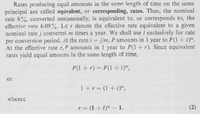Explain this!
Junior Member
- Joined
- Feb 7, 2019
- Messages
- 170
How can P(1 + r) = P(1 + i)m?
The first formula is for the amount after one year of simple interest, while the second is the amount after m years of compound interest. They will be equal if i = r and m = 1.
Why do you ask?
Because the formulaThe first formula is for the amount after one year of simple interest, while the second is the amount after m years of compound interest. They will be equal if i = r and m = 1.
Why do you ask?
[MATH]a^1 = a \text { always.}[/MATH]There is no particular reason for asking. I just saw this in a textbook, but I could not determine the solution to it.
Will m always need to equal 1 for this equation to be equal?
Please quote exactly what the book said. Did it ask this question, or did it just use the two different formulas in different contexts, and you wondered how they are related?There is no particular reason for asking. I just saw this in a textbook, but I could not determine the solution to it.
Will m always need to equal 1 for this equation to be equal?
Please quote exactly what the book said. Did it ask this question, or did it just use the two different formulas in different contexts, and you wondered how they are related?
If I were given the equation P(1 + r) = P(1 + i)m to solve, I would say that there are infinitely many combinations of r, i, and m that would make it true, and P can be any number at all. Give values for r and i, we could say that m = log(1+r)/log(1+i).
My quick answer was not intended as a solution of that equation, just an obvious observation that it would be true if (but not only if) the variables were matched up. My main point was that the two formulas as stated (which even have different variables for the rate, suggesting that they have different meanings) are commonly used in different contexts. They will happen to be equal under certain conditions, but that is meaningless, really.
In any case, I doubt that the book would intend any of this, which is why I want to see the source.
Will this be sufficient?

